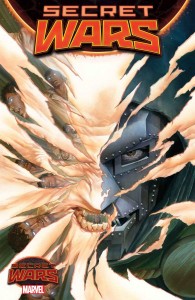 Secret Wars #5 ( of 8 ) — Writer: Jonathan Hickman; Art: Esad Ribic; Colors: Ive Svorcina
Secret Wars #5 ( of 8 ) — Writer: Jonathan Hickman; Art: Esad Ribic; Colors: Ive Svorcina
Secret Wars: A-Force #3 (of 5) — Writers: Marguerite Bennett and G. Willow Wilson; Pencils: Jorge Molina; Inks: Jorge Molina and Craig Yeung; Colors: Laura Martin
Secret Wars: Battleworld 4 (of 4) — (First Story): Writer/Artist: James Stokoe (Second Story): Writer: 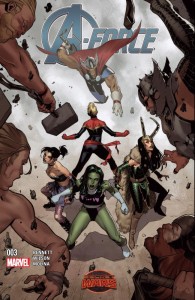 Peter David; Art: Daniel Valadez; Colors: David Curiel
Peter David; Art: Daniel Valadez; Colors: David Curiel
Secret Wars: Ghost Racers #3 (of 4) — Writer: Felipe Smith; Art: Juan Gedeon; Colors: Tamra Bonvillain
Secret Wars: Inhumans: Attilan #4 (of 5) — Writer: Charles Soule; Pencils: John Timms; Inks: Roberto Poggi; Colors: Frank D’Armata
 Secret Wars: Korvac Saga #3 (of 4) — Writer: Dan Abnett; Art: Otto Schmidt; Colors: Cris Peter
Secret Wars: Korvac Saga #3 (of 4) — Writer: Dan Abnett; Art: Otto Schmidt; Colors: Cris Peter
The first half of the Secret Wars books for the week — including, finally, the next installment of the series itself. This issue begins the story’s second half, as the consequences of Doom’s killing Dr. Strange start to become clear, he has a long conversation with the Molecule Man (who, no surprise, turns out to be central 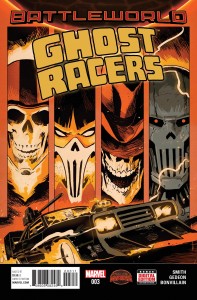 to everything), and Valeria gets tasked with finding the scattered pre-Battleworld survivors. It’s a mostly-quiet episode, but one laying the groundwork for a lot of fireworks later, and as always Hickman offers a complicated, clever script and Ribic very solid, solemnly-dramatic art; fans may or may not be getting tired of all the ancillary books in this event, but the main story continues to offer impressive storytelling. Meanwhile, A-Force deals with a traitor on the super-female-centric island of Arcadia, with the all-female title team fighting off mysterious transportation portals and
to everything), and Valeria gets tasked with finding the scattered pre-Battleworld survivors. It’s a mostly-quiet episode, but one laying the groundwork for a lot of fireworks later, and as always Hickman offers a complicated, clever script and Ribic very solid, solemnly-dramatic art; fans may or may not be getting tired of all the ancillary books in this event, but the main story continues to offer impressive storytelling. Meanwhile, A-Force deals with a traitor on the super-female-centric island of Arcadia, with the all-female title team fighting off mysterious transportation portals and 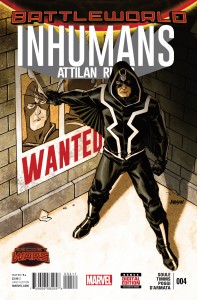 butthead Thors, and setting up smooth, interesting character dynamics that should bear fruit when the real-Marvel-universe version of this title debuts in a few months. Battleworld, the anthology title, ends its run with two Silver Surfer stories: the Stokoe-created one has an ancient-Egyptian version of Norrin Radd, and is notable for its detailed, Geoff Darrowesque art, while the second is a Peter David-written Surfer-vs.-The-Maestro tale, short but well-crafted. Ghost Racers keeps up its look at the Robbie Reyes incarnation of the Spirit of Vengeance, versus most of the others in an Arcade-run Death Race 2000–
butthead Thors, and setting up smooth, interesting character dynamics that should bear fruit when the real-Marvel-universe version of this title debuts in a few months. Battleworld, the anthology title, ends its run with two Silver Surfer stories: the Stokoe-created one has an ancient-Egyptian version of Norrin Radd, and is notable for its detailed, Geoff Darrowesque art, while the second is a Peter David-written Surfer-vs.-The-Maestro tale, short but well-crafted. Ghost Racers keeps up its look at the Robbie Reyes incarnation of the Spirit of Vengeance, versus most of the others in an Arcade-run Death Race 2000– like arena. Inhumans has a captured, non-powered Black Bolt (we find out that this version of the character refused the terrigen-mist metamorphosis, explaining why he can talk) being interrogated by Medusa, and trying to convince her of the underlying corrupt nature of Battleworld; if you suspect that he might be successful enough to get her to switch sides, and unite the Inhumans for a big battle against the Thors in the final issue next month… then congratulations! You can plot comics too! It’s fine, although the art’s too undistinguished to elevate the standard script. Korvac Saga has a similar problem: Schmidt does a decent job on the big panels, like the cover and the last-page splash, but otherwise the art just doesn’t stand out — although Abnett’s script finally revs up, and suggests a big Korvac/Doom battle in the final issue next month.
like arena. Inhumans has a captured, non-powered Black Bolt (we find out that this version of the character refused the terrigen-mist metamorphosis, explaining why he can talk) being interrogated by Medusa, and trying to convince her of the underlying corrupt nature of Battleworld; if you suspect that he might be successful enough to get her to switch sides, and unite the Inhumans for a big battle against the Thors in the final issue next month… then congratulations! You can plot comics too! It’s fine, although the art’s too undistinguished to elevate the standard script. Korvac Saga has a similar problem: Schmidt does a decent job on the big panels, like the cover and the last-page splash, but otherwise the art just doesn’t stand out — although Abnett’s script finally revs up, and suggests a big Korvac/Doom battle in the final issue next month.
 Secret Wars: Master of Kung Fu #4 (of 4) — Haden Blackman; Pencils: Dalibor Talajic; Inks: Goran Sudzuka; Colors: Miroslav Mrva
Secret Wars: Master of Kung Fu #4 (of 4) — Haden Blackman; Pencils: Dalibor Talajic; Inks: Goran Sudzuka; Colors: Miroslav Mrva
Secret Wars: Mrs. Deadpool and the Howling Commandoes #3 (of 4) — Writer: Gerry Duggan; Art: Salva Espin; Colors: Val Staples
Secret Wars: Planet Hulk #4 (of 5) — Writer: Sam Humphries; Art: Marc Laming; Colors: Jordan Boyd
 Secret Wars: 2099 #4 (of 5) — Writer: Peter David; Art: Will Sliney; Colors: Antonio Fabela
Secret Wars: 2099 #4 (of 5) — Writer: Peter David; Art: Will Sliney; Colors: Antonio Fabela
Secret Wars: Star-Lord and Kitty Pryde #2 (of 3) — Writer: Sam Humphries; Art: Alti Firmansyah; Colors: Jessica Kholinne
Secret Wars: Years of Future Past #4 (of 5) — Writer:  Marguerite Bennett; Art: Mike Norton; Colors: FCO Plascencia
Marguerite Bennett; Art: Mike Norton; Colors: FCO Plascencia
Of the second half of the tie-ins, Master of Kung Fu is the first to reach its conclusion, and continues to be a pleasant surprise, with a Francisco Francavilla cover that harks back to all the classic Mick Zeck MOKF covers of the ’70s, and a story that borrows from Hong Kong chop-socky movies and makes affectionate use of  Marvel’s many martial-arts characters. Mrs. Deadpool is a Wade book without a lot of Wade (although he’s hanging around as a ghostly commentator/kibitzer), as the title character, Shiklah, leads a bunch of Marvel monster characters in a battle against Dracula; it’s another book that’s setting up for a big fight in its final issue next month, although it’s distinguished by its typically-Deadpooly tongue-in-cheek tone. Planet Hulk, also on its penultimate issue, finally gets Captain America and Devil Dinosaur to their
Marvel’s many martial-arts characters. Mrs. Deadpool is a Wade book without a lot of Wade (although he’s hanging around as a ghostly commentator/kibitzer), as the title character, Shiklah, leads a bunch of Marvel monster characters in a battle against Dracula; it’s another book that’s setting up for a big fight in its final issue next month, although it’s distinguished by its typically-Deadpooly tongue-in-cheek tone. Planet Hulk, also on its penultimate issue, finally gets Captain America and Devil Dinosaur to their  destination in the gamma-saturated section of Battleworld, only to face disappointment; it’s got OK-looking art, but a mostly-depressing script that could have used some of Deadpool’s lighter touch. Secret Wars 2099 shows just how to do that, as Peter David’s an old pro at combining adventure, drama and humor in just the right amounts, and uses them effectively in describing a future-Avengers vs. future-Defenders clash. Star-Lord and Kitty Pryde is also on its next-to-last issue, even though this is only its second one (it’s only a three-issue series, rare for these tie-ins),
destination in the gamma-saturated section of Battleworld, only to face disappointment; it’s got OK-looking art, but a mostly-depressing script that could have used some of Deadpool’s lighter touch. Secret Wars 2099 shows just how to do that, as Peter David’s an old pro at combining adventure, drama and humor in just the right amounts, and uses them effectively in describing a future-Avengers vs. future-Defenders clash. Star-Lord and Kitty Pryde is also on its next-to-last issue, even though this is only its second one (it’s only a three-issue series, rare for these tie-ins), 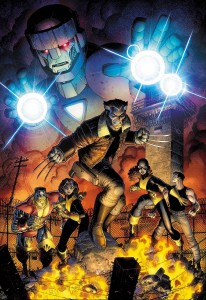 as the Peter Quill who’s a fugitive from the “old” universe encounters a Kitty from Battleworld, who works for Doom and, of course, has no memory of him and thinks he’s crazy — but feels an inexplicable attraction to him anyway…. Finally, Years of Future Past is yet another next-to-last issue, involving that classic X-Men alternate future; it’s a slightly-above-average comic that seems a little worse than it is, just because its original source material is so hard to live up to (it’s also interesting because it’s one of three books this week scripted by Marguerite Bennett — two for Marvel and Bombshells #1 for DC — which represents an eye-opening hat trick for a relative newcomer).
as the Peter Quill who’s a fugitive from the “old” universe encounters a Kitty from Battleworld, who works for Doom and, of course, has no memory of him and thinks he’s crazy — but feels an inexplicable attraction to him anyway…. Finally, Years of Future Past is yet another next-to-last issue, involving that classic X-Men alternate future; it’s a slightly-above-average comic that seems a little worse than it is, just because its original source material is so hard to live up to (it’s also interesting because it’s one of three books this week scripted by Marguerite Bennett — two for Marvel and Bombshells #1 for DC — which represents an eye-opening hat trick for a relative newcomer).
 The Unbeatable Squirrel Girl #8 — Writer: Ryan North; Art: Erica Henderson; Colors: Rico Renzi
The Unbeatable Squirrel Girl #8 — Writer: Ryan North; Art: Erica Henderson; Colors: Rico Renzi
The Amazing Spider-Man #20.1 — Writer: Gerry Conway; Pencils: Carlo Barberi; Inks: Juan Vlasco; Colors: Israel Silva
A couple of non-Secret Wars Marvel books — Squirrel Girl continues its impressive debut year, with both the writing and the art showing a light touch and quirky humor, underneath which lurks some surprisingly-subtle characterization and theme (the only book I can  think of to compare it to is Lumberjanes, which is high praise), while Amazing Spider-Man‘s silly .1 numbering is actually concealing a mini-series, set in current continuity, by really old-school (as in, he was writing the book over forty years ago) author Gerry Conway; as you might expect, it’s a very well-constructed, classic mobster-war-and-conflicted-heroes plot, concluding in this issue, involving sometime Spider-ally The Wraith, along with villain Mr. Negative and the Black Cat, and it’s perfect if you’re tired of all the Secret Wars stuff and just want to read a straight-ahead Marvel superhero story.
think of to compare it to is Lumberjanes, which is high praise), while Amazing Spider-Man‘s silly .1 numbering is actually concealing a mini-series, set in current continuity, by really old-school (as in, he was writing the book over forty years ago) author Gerry Conway; as you might expect, it’s a very well-constructed, classic mobster-war-and-conflicted-heroes plot, concluding in this issue, involving sometime Spider-ally The Wraith, along with villain Mr. Negative and the Black Cat, and it’s perfect if you’re tired of all the Secret Wars stuff and just want to read a straight-ahead Marvel superhero story.
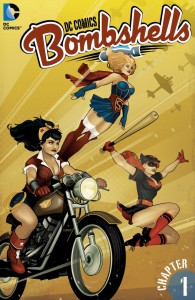 DC Comics: Bombshells #1 — Writer: Marguerite Bennett; Art/Colors: Marguerite Savage
DC Comics: Bombshells #1 — Writer: Marguerite Bennett; Art/Colors: Marguerite Savage
Justice League: Gods and Monsters #1 — Story: J.M. DeMatteis and Bruce Timm; Script: J.M. DeMatteis; Art: Thony Silas; Colors: Tony Avina
Two DC debuts: Bombshells is based on those DC alternate covers using fake WWII aircraft pin-up art from last year, and could have been really sexist and stupid; fortunately, DC got two actual, you know, women to write and draw it, and they provide a 1940-set milieu in which there’s a Katy Kane Batwoman (but no Batman) in Gotham City, a Wonder Woman whose Paradise Island off the coast of Greece sees a Nazi-fighting pilot — Steve Trevor — wash up on it, and a Russian Air Force pilot named Kara who’s secretly a version of Supergirl; presumably, these three will all hook up and become the heroines we see on the cover. The Sauvage arc is lush, nicely-stylized and pretty, a good match for the time period, and the Bennett script is effective at covering a lot of ground in its thirty pages, introducing all three women, filling in their backgrounds and beginning their stories; 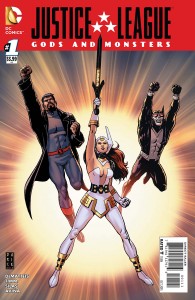 this is a good start at what could become a breakout hit. Justice League: Gods and Monsters unites its three alternate-universe versions of Batman (a vampiric Kirk Langstrom), Superman (who was found as an infant and raised by Hispanic migrant workers) and Wonder Woman (a New God who got stranded here in the ’60s by a Boom Tube) that we’ve had solo origins for in the last few weeks, in what appears to be an ongoing book; its average art is helped by its being based on a new direct-to-video cartoon from Bruce Timm and company, which gives the overall story enough imagination to create some buzz — assuming readers aren’t too fatigued by alternate worlds at this point….
this is a good start at what could become a breakout hit. Justice League: Gods and Monsters unites its three alternate-universe versions of Batman (a vampiric Kirk Langstrom), Superman (who was found as an infant and raised by Hispanic migrant workers) and Wonder Woman (a New God who got stranded here in the ’60s by a Boom Tube) that we’ve had solo origins for in the last few weeks, in what appears to be an ongoing book; its average art is helped by its being based on a new direct-to-video cartoon from Bruce Timm and company, which gives the overall story enough imagination to create some buzz — assuming readers aren’t too fatigued by alternate worlds at this point….
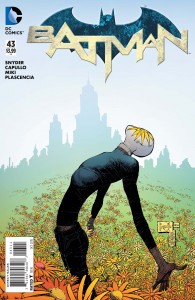 Batman #43 — Writer: Scott Snyder; Pencils: Greg Capullo; Inks: Danny Miki; Colors: FCO Plascencia
Batman #43 — Writer: Scott Snyder; Pencils: Greg Capullo; Inks: Danny Miki; Colors: FCO Plascencia
Batman/Superman #23 — Writer: Greg Pak; Art: Ardian Syaf and Vicente Cifuentes; Colors: Beth Sotelo
Action Comics #43 — Writer: Greg Pak; Art: Aaron Kuder; Colors: Tomeu Morey
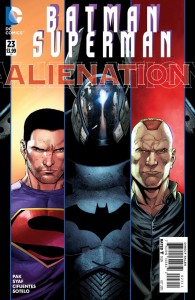 All-Star Section Eight #3 (of 6) — Writer: Garth Ennis; Art: John McRea; Colors: John Kalisz
All-Star Section Eight #3 (of 6) — Writer: Garth Ennis; Art: John McRea; Colors: John Kalisz
Some of the week’s other DC books of interest — three of which involve the new versions of Batman and Superman, both of whom have managed to generate some fan heat. Batman shows us a Bruce Wayne who can’t be Batman any more, for clever reasons that Alfred explains to Jim Gordon, who’s 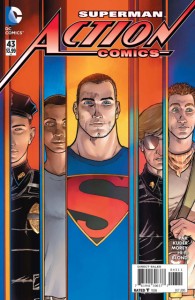 now filling the role; it also continues introducing a creepy and not-quite-human new bad guy, Mr. Bloom, as the Snyder/Capullo team keeps making this the best-selling book on the stands. Batman/Superman teams Gordon up with a now-vastly-depowered Clark Kent, currently a fugitive whose identity has been exposed to the world; it’s got a pedestrian plot about a race of underground warriors blah blah blah, but it’s fun watching the two “new” versions of the heroes instantly dislike, and then
now filling the role; it also continues introducing a creepy and not-quite-human new bad guy, Mr. Bloom, as the Snyder/Capullo team keeps making this the best-selling book on the stands. Batman/Superman teams Gordon up with a now-vastly-depowered Clark Kent, currently a fugitive whose identity has been exposed to the world; it’s got a pedestrian plot about a race of underground warriors blah blah blah, but it’s fun watching the two “new” versions of the heroes instantly dislike, and then 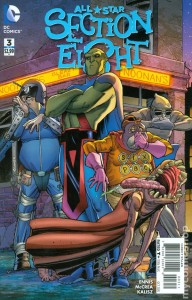 develop a grudging respect, for one another. Action continues its Kent-versus-the-police arc, one that got some media criticism when some Fox commentators thought it was referencing places like Ferguson and dissing the men in blue; unsurprisingly, it turns out that writer Pak had something much different, and considerably less reality-based, in mind. After three such serious books, All-Star Section Eight offers a nice change of pace: cynical, scatological (although subtle about it) and morbidly funny, exactly what you’d expect from the Ennis/McRea team.
develop a grudging respect, for one another. Action continues its Kent-versus-the-police arc, one that got some media criticism when some Fox commentators thought it was referencing places like Ferguson and dissing the men in blue; unsurprisingly, it turns out that writer Pak had something much different, and considerably less reality-based, in mind. After three such serious books, All-Star Section Eight offers a nice change of pace: cynical, scatological (although subtle about it) and morbidly funny, exactly what you’d expect from the Ennis/McRea team.
 Phonogram: The Immaterial Girl #1 (of 6) — Writer: Kieron Gillen; Art: Jamie McKelvie; Colors: Matthew Wilson
Phonogram: The Immaterial Girl #1 (of 6) — Writer: Kieron Gillen; Art: Jamie McKelvie; Colors: Matthew Wilson
The Eltingville Club #2 (of 2) — Writer/Artist: Evan Dorkin; Colors: Sarah Dyer
The Beauty #1 — Writer: Jason A. Hurley; Art: Jeremy Haun; Colors: John Rauch
There were a bunch of cool indy books this week — fourteen of them — so let’s look at the first issues first, and then take a quick run-through on the rest. Phonogram gets pride of place, because it’s the third 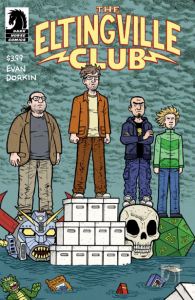 volume of the seminal series from Gillen and McKelvie about British pop fans who are phonomancers — they tap into the (literal) magic of pop music — and the first two volumes were universally praised by critics and criminally underread by fans. Don’t be those people: buy this and appreciate its sleek, modern art and ambitious hipster charm, and make it the hit it deserves to be. In any non-Phonogram week, Eltingville Club would have been on top — it’s a second issue, but really a stand-alone epilogue to Dorkin’s decades-long series about four teens who put the “fanatic” in “comics fan,” giving him a license to skewer every anti-social, self-centered, mysogonistic and borderline-psychotic personality trait exhibited by… well, you know: us. This episode is set ten
volume of the seminal series from Gillen and McKelvie about British pop fans who are phonomancers — they tap into the (literal) magic of pop music — and the first two volumes were universally praised by critics and criminally underread by fans. Don’t be those people: buy this and appreciate its sleek, modern art and ambitious hipster charm, and make it the hit it deserves to be. In any non-Phonogram week, Eltingville Club would have been on top — it’s a second issue, but really a stand-alone epilogue to Dorkin’s decades-long series about four teens who put the “fanatic” in “comics fan,” giving him a license to skewer every anti-social, self-centered, mysogonistic and borderline-psychotic personality trait exhibited by… well, you know: us. This episode is set ten  years after the previous issue, so the guys are all in their mid-to-late twenties when they meet up accidentally at the San Diego Comic Con — and what happens next is darkly hilarious, obsessively-detailed, psychologically-dead-on slapstick satire that no true fan should miss, a fitting end to a great under-the-radar classic. That leaves The Beauty, a new series with a high-concept sf hook about a venereal disease that makes its victims… beautiful, buff and in top physical condition. I’m not sure if it’ll be able to sustain its momentum — the two big plot twists in this first issue are exactly what I would have predicted — but that main idea’s interesting enough to make it worth following for a couple of issues, at least.
years after the previous issue, so the guys are all in their mid-to-late twenties when they meet up accidentally at the San Diego Comic Con — and what happens next is darkly hilarious, obsessively-detailed, psychologically-dead-on slapstick satire that no true fan should miss, a fitting end to a great under-the-radar classic. That leaves The Beauty, a new series with a high-concept sf hook about a venereal disease that makes its victims… beautiful, buff and in top physical condition. I’m not sure if it’ll be able to sustain its momentum — the two big plot twists in this first issue are exactly what I would have predicted — but that main idea’s interesting enough to make it worth following for a couple of issues, at least.
 The Fade-Out #8 — Writer: Ed Brubaker; Art: Sean Phillips; Colors: Elizabeth Breitweiser
The Fade-Out #8 — Writer: Ed Brubaker; Art: Sean Phillips; Colors: Elizabeth Breitweiser
Velvet #11 — Writer: Ed Brubaker; Art: Steve Epting; Colors: Elizabeth Breitweiser
Stumptown #7 — Writer: Greg Rucka; Art: Justin Greenwood; Colors: Ryan Hill
21st Century Tank Girl #3 — Writer: Alan Martin; Art: 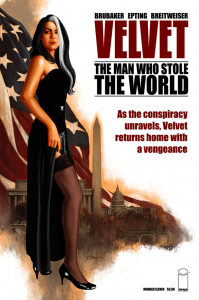 Jim Mahfood; Craig Knowles
Jim Mahfood; Craig Knowles
18 Days #2 — Writers: Grant Morrison, Gotham Chopra and Sharad Devarajan; Art: Jeevan J. Kang; Colors: S. Sundarakannan
Empire: Uprising #4 — Writer: Mark Waid; Art: Barry Kitson; Colors: Chris Sotomayor
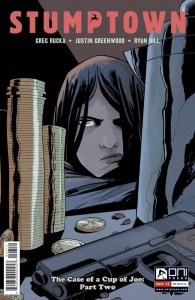 Injection #4 — Warren Ellis; Art: Declan Shalvey; Colors: Jordie Bellaire
Injection #4 — Warren Ellis; Art: Declan Shalvey; Colors: Jordie Bellaire
Mercury Heat #2 — Writer: Kieron Gillen; Art: Omar Francia
ODY-C #6 — Writer: Matt Fraction; Art/Colors: Christian Ward
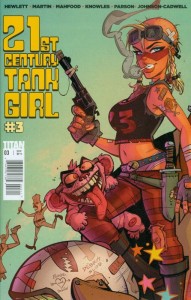 Providence #3 — Writer: Alan Moore; Art: Jacen Burrows; Colors: Juan Rodriguez
Providence #3 — Writer: Alan Moore; Art: Jacen Burrows; Colors: Juan Rodriguez
Rebels #5 — Writer: Brian Wood; Art: Andrea Mutti; Colors: Jordie Bellair
The other eleven indy books of note: The Fade-Out is hardboiled film noir set in late-1940s Hollywood, with a murdered actress, a blacklisted writer, corrupt studio executives,  flamboyant stars, a tough-guy studio security head and lots of other characters being put through their paces by the polished Brubaker/Phillips team. Brubaker’s also the writer for Velvet, a ’60s spy comic whose lead is a former agent-turned-secretary, framed as a traitor and on the run, whose Diana Rigg-level skills all the guys keep underestimating; it’s very stylishly (and sexily) drawn by Steve Epting, Brubaker’s old Captain America partner. More tough-guy — or, rather, tough-gal — detective work
flamboyant stars, a tough-guy studio security head and lots of other characters being put through their paces by the polished Brubaker/Phillips team. Brubaker’s also the writer for Velvet, a ’60s spy comic whose lead is a former agent-turned-secretary, framed as a traitor and on the run, whose Diana Rigg-level skills all the guys keep underestimating; it’s very stylishly (and sexily) drawn by Steve Epting, Brubaker’s old Captain America partner. More tough-guy — or, rather, tough-gal — detective work 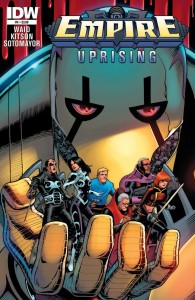 is on display over in Greg Rucka’s Stumptown, with an ex-military female lead who’s a Portland private investigator involved in very Portlandia-centric cases (her current one involves a gourmet coffee importer whose civit-farmed kopi luwak beans are worth $20,000 per eight ounces) that are well-researched and well-told. 21st Century Tank Girl offers new stories of that now-obscure ’90s Mad Maxish sf star, written by original creator Alan Martin; the main one is noteworthy for its sixteen pages of art from former
is on display over in Greg Rucka’s Stumptown, with an ex-military female lead who’s a Portland private investigator involved in very Portlandia-centric cases (her current one involves a gourmet coffee importer whose civit-farmed kopi luwak beans are worth $20,000 per eight ounces) that are well-researched and well-told. 21st Century Tank Girl offers new stories of that now-obscure ’90s Mad Maxish sf star, written by original creator Alan Martin; the main one is noteworthy for its sixteen pages of art from former  Phoenix resident Jim Mahfood, whose detailed pencils and underground sensibilities are a perfect match for the character (there’s also a four-page story by Craig Knowles, three pages from Brett Parson, and a double-page centerfold courtesy of Jamie Hewlett, the book’s original artist who went on to big-time musical fame as the animator behind The Gorillaz). Then, there’s 18 Days, Grant Morrison’s adaptation of the Indian epic The
Phoenix resident Jim Mahfood, whose detailed pencils and underground sensibilities are a perfect match for the character (there’s also a four-page story by Craig Knowles, three pages from Brett Parson, and a double-page centerfold courtesy of Jamie Hewlett, the book’s original artist who went on to big-time musical fame as the animator behind The Gorillaz). Then, there’s 18 Days, Grant Morrison’s adaptation of the Indian epic The  Mahabharata, with the title time span referring to the length of the world-shaking battle fought by two super-warrior armies in the mists of prehistory; it’s a tale not all that different from, say, Secret Wars, if you squint a little. Empire: Uprising continues Mark Waid’s series about a world where, in effect, Lex Luthor defeated Superman and took over the world (although, of course, none of the characters have those names), and then what happened next, with particular attention to all the
Mahabharata, with the title time span referring to the length of the world-shaking battle fought by two super-warrior armies in the mists of prehistory; it’s a tale not all that different from, say, Secret Wars, if you squint a little. Empire: Uprising continues Mark Waid’s series about a world where, in effect, Lex Luthor defeated Superman and took over the world (although, of course, none of the characters have those names), and then what happened next, with particular attention to all the 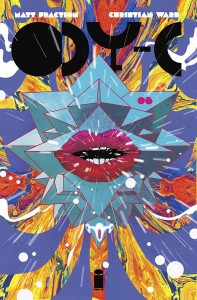 backstabbing ministers and hangers-on of his inner court of advisors; it’s clever and well-constructed, as all of Waid’s stories are, and enhanced by the efficient, attractive Kitson art. Injection looks and reads even better — it’s by the Ellis/Shalvey team that provided such a stylish first six issues to the last volume of Moon Knight — and it’s about a woman who used to be part of a metaphysical research group who created, or released, something terrible, and has been trying to make up for it by battling weird occult incursions into our world. Mercury Heat
backstabbing ministers and hangers-on of his inner court of advisors; it’s clever and well-constructed, as all of Waid’s stories are, and enhanced by the efficient, attractive Kitson art. Injection looks and reads even better — it’s by the Ellis/Shalvey team that provided such a stylish first six issues to the last volume of Moon Knight — and it’s about a woman who used to be part of a metaphysical research group who created, or released, something terrible, and has been trying to make up for it by battling weird occult incursions into our world. Mercury Heat  and ODY-C are both sf books, but otherwise very different; Mercury Heat is about yet another tough-gal female cop, one who’s new to an outpost on the planet Mercury and, inevitably, has to deal with a murder mystery and mysterious assassins. ODY-C is on a much larger canvas; it’s Matt Fraction’s attempt to recreate The Odyssey in a cosmos-spanning matriarchal society, with a ship wandering the spaceways as it tries to get home after a long universal war; in this issue, he breaks from the Greek epic plot to mix in some bits of the Arabian 1001 Nights, not to mention Moby Dick. That’s a lot to
and ODY-C are both sf books, but otherwise very different; Mercury Heat is about yet another tough-gal female cop, one who’s new to an outpost on the planet Mercury and, inevitably, has to deal with a murder mystery and mysterious assassins. ODY-C is on a much larger canvas; it’s Matt Fraction’s attempt to recreate The Odyssey in a cosmos-spanning matriarchal society, with a ship wandering the spaceways as it tries to get home after a long universal war; in this issue, he breaks from the Greek epic plot to mix in some bits of the Arabian 1001 Nights, not to mention Moby Dick. That’s a lot to 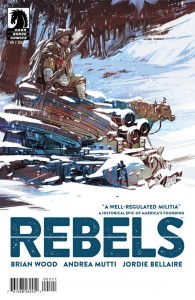 absorb, especially through Ward’s psychedelic, experimental panel layouts and art, but the challenge pays off for persistent readers, and you have to encourage a series with goals as big as this one’s. That leaves Providence, Alan Moore’s creeping-paranoia Lovecraftian pastiche set in early-twentieth-century New England, and Rebels, Brian Wood’s historical fiction set 150 years before that, in the early days of the Revolutionary War. In the latter, the lead character, one of Ethan Allen’s Green Mountain Boys, tries to shepherd a number of heavy cannon on a journey to Boston; it continues to be a well-researched, beautifully-drawn and fascinating look at a critical period of US history that most of us know too little about.
absorb, especially through Ward’s psychedelic, experimental panel layouts and art, but the challenge pays off for persistent readers, and you have to encourage a series with goals as big as this one’s. That leaves Providence, Alan Moore’s creeping-paranoia Lovecraftian pastiche set in early-twentieth-century New England, and Rebels, Brian Wood’s historical fiction set 150 years before that, in the early days of the Revolutionary War. In the latter, the lead character, one of Ethan Allen’s Green Mountain Boys, tries to shepherd a number of heavy cannon on a journey to Boston; it continues to be a well-researched, beautifully-drawn and fascinating look at a critical period of US history that most of us know too little about.



